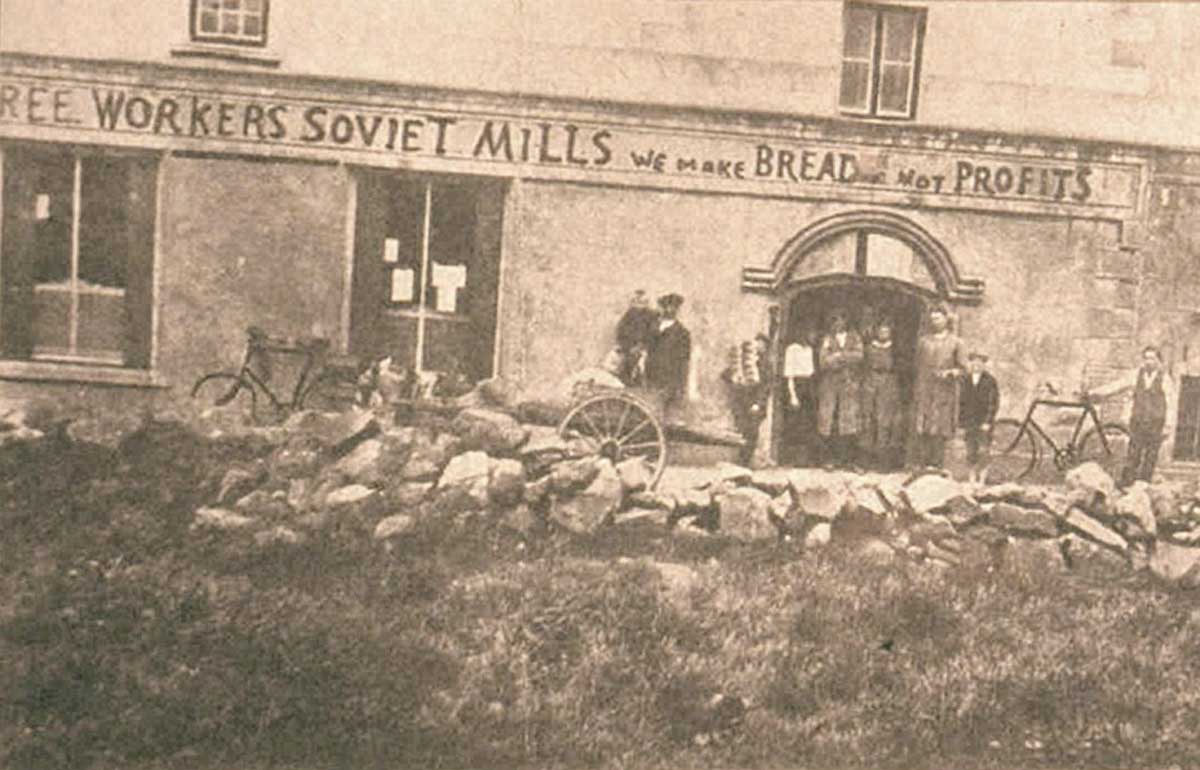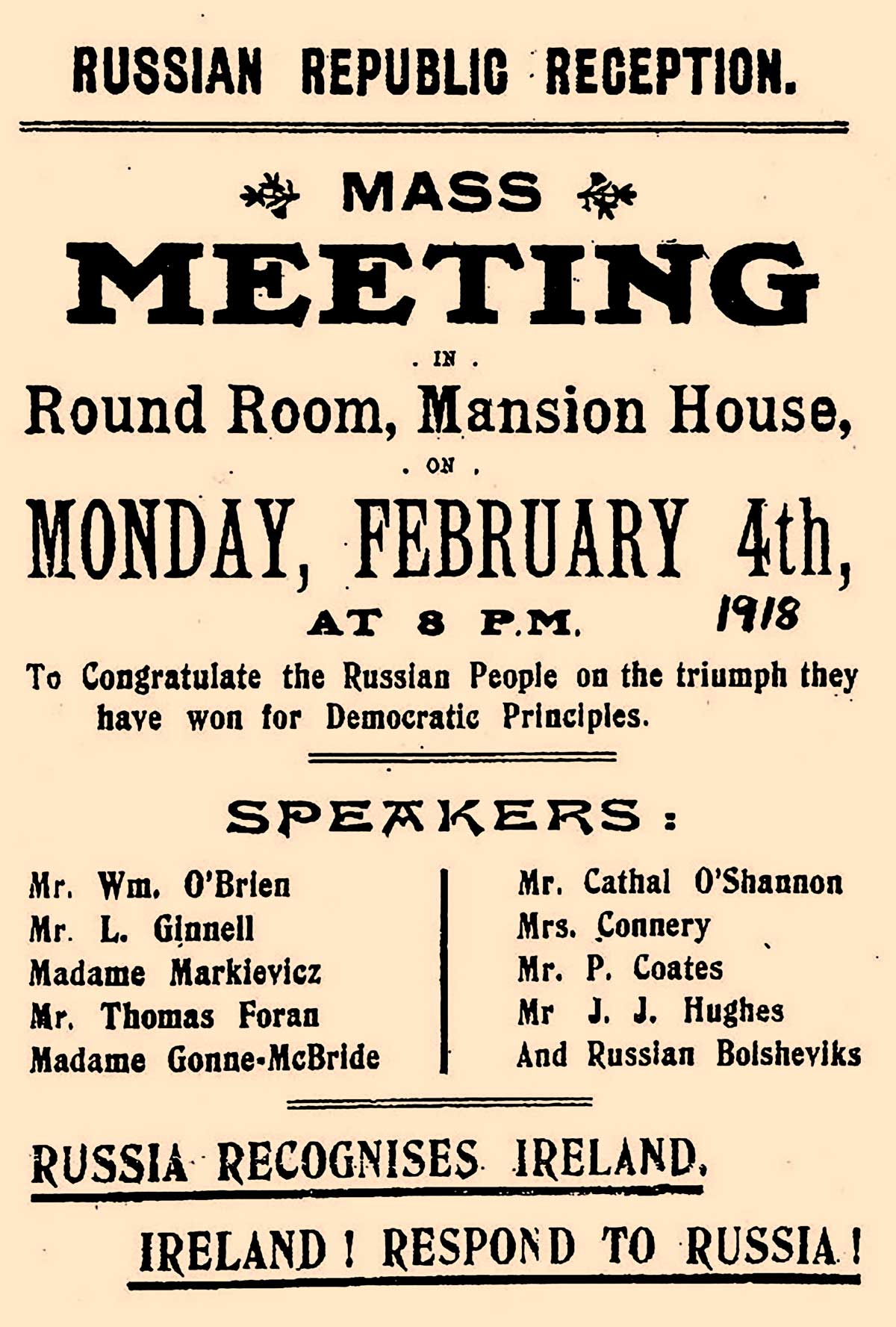The First Soviet in Ireland
Striking for better working conditions and equal pay, the attendants and patients of Monaghan asylum took over the hospital and hoisted a red flag.

The burgeoning Soviet Union and the nascent Irish Republic seemed to give inspiration to each other, despite – or maybe precisely because of – the peculiar mixes of class and national interests they shared. Lenin, who reportedly spoke English with an Irish accent, was an admirer of the 1916 Easter Rising, the Irish republican insurrection against British rule. He saw national self-determination as a stepping stone to overturning western imperialism, which would inevitably lead to class-based revolution. With its religious aspects downplayed, the Rising remained a popular subject in the Soviet Union for decades to come. The Rising’s 50th anniversary was marked at the first Party Congress under Brezhnev and was widely celebrated and written about. In turn, the Soviet Union’s anti-British, anti-colonialist and anti-war stance energised the Irish independence movement; in 1917 some 10,000 people celebrated the Bolshevik coup at Dublin’s Mansion House. A year later the Declaration of Irish Independence was announced in the same building.
In revolutionary Ireland, the working class labour struggle was having its moment as well. Conditions for Irish asylum attendants were grim. They lived on the grounds in overcrowded conditions, their lives controlled by their superiors: they could be fired without warning for a wide range of offences, including intemperance, unkindness, gossiping or disobeying orders, even if asked to do something that was not part of their job.
Class prejudice did not help their subservient position – it was not uncommon for medical superintendents to question staff’s competence explicitly because they came from the same ‘rank’ as the patients.
Yearly salaries were extremely low for male attendants (as little as £60, or £3,500 today) and even lower for women – in many cases half of what the men made. Staff regularly worked over 80 hours per week with little time off and the labour was both physically and psychologically demanding. The Monaghan asylum’s patients were some of the most severely ill in Ireland.
During the First World War, living costs rose drastically in Ireland, while the already dismal pay for psychiatric staff did not. In response, trade unionism exploded in popularity. In fact, the Monaghan staff themselves had staged a small strike in March 1918, though it did not achieve much.
It is under these circumstances that the Monaghan activists invited Peadar O’Donnell to lead the negotiations in December 1918. At the time, the 25-year-old was a labour organiser for the most militant workers’ union in Ireland and was just starting his long career as one of the most radical, persistent and high profile leftists in the country.
O’Donnell led two fruitless meetings with Monaghan’s management. The demands were rejected. Less than a week later, on 24 January, three days after the Declaration of Irish Independence, the staff of the Monaghan asylum went back on strike.
Although the management agreed to most of the strikers’ demands almost immediately, they were resistant to equal pay for their female staff. It was on this point that negotiations broke down and the strike continued.

Since abandoning their patients could be dangerous, the strikers pioneered the stay-in strike and barricaded themselves in to run the asylum, rather than refusing to come to work. News that they had ‘established a local soviet or committee, consisting of the staff and inmates, to run the asylum’ made it all the way to the House of Commons.
The police response did not go as planned. The authorities planned for a swift and firm crackdown by having over 100 policemen besiege the hospital. Instead, the two sides played football and held dances. The son of one of the strikers even later claimed that some attendants would trade uniforms with the police to sneak out of the asylum during the strike.
On the fifth day of the strike, the strikers were tipped off about an order to storm the building. To confuse them and disrupt the charge, the attendants and their patients swapped clothes, blocked the entrances and armed themselves with shovels and pitchforks. Ultimately, the situation did not escalate, as a priest was sent to restart negotiations. He was received by an old woman limping over with a red handkerchief on her head to match the red flag that had been hoisted over the building. She lifted her skirt to reveal a pair of trousers – it was O’Donnell.
The occupation was a success. The management bitterly conceded defeat. There was to be no victimisation of the activists. The workers were granted a 56-hour week, married attendants could leave the asylum after work and women received the same pay rise as men. On 3 February, the final night of the takeover, the strikers, the police and some patients held a dance to celebrate.
Despite widespread condemnation, the Monaghan strike had a lasting impact on labour organisation in Ireland. Before this, there had been only one small occupation – of a Dublin tailor’s workshop in 1918. In the next four years, there were at least another hundred, some on a fairly large scale. In the most widely known, workers took over Limerick in response to British military overreach. The Limerick soviet lasted for two weeks, during which it controlled food resources, printed its own money and published a newspaper.
Notably, despite O’Donnell’s socialist leanings, the Monaghan ‘soviet’ may seem like a misnomer. The strikers wanted nothing more than better working conditions and, having attained them, the workers’ council was dissolved and things returned to normal. This was a far cry from world revolution but, on the whole, that was not the goal of the Irish soviet movement. Soon enough, even these social rumblings ended up being subsumed by the Irish nationalist cause. National self-determination took priority over class-based concerns.
In retrospect, the brief Irish flirtation with the Soviet Union seems both inevitable and doomed. A small state trying to establish itself must look for potential allies wherever it can; but the overwhelmingly Roman Catholic nationalist Ireland and the forcibly atheist internationalist USSR were not lasting partners.
Urte Laukaityte is a PhD candidate at the University of California, Berkeley.